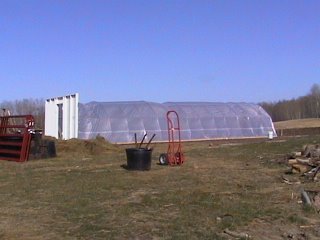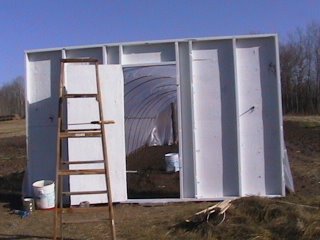
The above picture is our finished hoop house. We used old plywood for the wooden side, but purchased rebar for the hoops. Our friend Paulette had extra reinforced plastic, so we were able to use that to cover the hoops. With our friend Steve's help, Jim and the boys did a very good job of getting the structure up.

This is the official entrance to the hoop house; I'm glad we can close it off, as the dogs have yet to learn to stay out of there! We will leave it open during the day and also open up part of the back side, in order to allow the breeze to flow through. At night we can close it off and keep the warmth inside. Jim may install an old wood stove to use if the nights get too chilly (as it did last night, and the night before we actually had snow!). We also may add a stock tank in there, so the water we pull up from the slough can warm up before we use it on the plants.
 Here is a picture of the inside. Before we left to spend the rest of the day helping out a friend, Paulette and I planted tomatoes, cayenne peppers, cucumbers and sugar pumpkins. We are growing with open polinated seeds this year, so hopefully we'll be successful in saving seeds for next year. Steve said he was impressed with the quality of the soil, as it was just part of the open field last year. Steve had given our boys the job of running around and around the field with his garden tractor, using some sort of attachment (you can tell I am not farm savy yet!) to break up the "summer fallow." He also helped us with getting dump truck loads of aged sheep manure, and that really did the trick. I guess there weren't any weeds to pull out before we began planting.
Here is a picture of the inside. Before we left to spend the rest of the day helping out a friend, Paulette and I planted tomatoes, cayenne peppers, cucumbers and sugar pumpkins. We are growing with open polinated seeds this year, so hopefully we'll be successful in saving seeds for next year. Steve said he was impressed with the quality of the soil, as it was just part of the open field last year. Steve had given our boys the job of running around and around the field with his garden tractor, using some sort of attachment (you can tell I am not farm savy yet!) to break up the "summer fallow." He also helped us with getting dump truck loads of aged sheep manure, and that really did the trick. I guess there weren't any weeds to pull out before we began planting. This is the back side, which can be opened when we want to allow a breeze to flow through the hoop house. The stakes you see sticking up from the ground are markers for the rows of potatoes/peas/carrots that were planted (I'll have to ask the boys which crop was planted behind the structure).
This is the back side, which can be opened when we want to allow a breeze to flow through the hoop house. The stakes you see sticking up from the ground are markers for the rows of potatoes/peas/carrots that were planted (I'll have to ask the boys which crop was planted behind the structure).
This method of planting inside the hoop house will greatly enhance our gardening this year, as the growing season is very short up here by the Canadian border. We are so very grateful to the Lord for the resources to build it, and also for our friends Steve and Paulette, who have helped us with the knowledge they have of gardening and also their physical labor.
Emily (Straining Onward) asked me about our well water, and why it was recommended to not use it on our gardens. I pulled out the report we received from the ND Dept. of Health after testing a sample, and this is the information we received.
Specific Conductance: 1467 micromhos/cm: This places our water in the C-3 category, which states: "High salinity water should be used only on soils of moderate to good permeability. Leaching is needed to prevent serious soil salinity." It also stated we are in the S-1 category, as we have low sodium; this comment states: "Low sodium water can be used on almost all soils with little danger of accumulating harmful amounts of exchangeable sodium."
The other categories tested stated:
Total Dissolved Solids: 1100 mg/l -- Satisfactory
Total Hardness: 100+ Grains/Gallons, which is very high
Iron: 0, which of course is low
Nitrate: Less than 2 mg/l -- Satisfactory
For a private domestic supply, this water would be usable, but not desirable (sounds like we need a water filtration system for the house!)
For irrigation purposes, this water may be injurious and its effect on the soil, over a period of years, may prove harmful to all but the most tolerant plant life.
So, with the combination of everything, we will avoid using it on our gardens. It doesn't taste all that great, either, but we do drink it all the time. I learned the hard way that I cannot use bleach in my water when washing clothes, as whatever is in the water mixing with bleach causes my white clothes to turn brown!

6 comments:
Looks Good!!
Andrew B.
Good Report Lynn.
Love the pictures.
Wonder what the lake water is like.
Looks like hoop house could be used for a garage in the winter.
Gp B
Looks like fun! Greenhouses can be so worthwhile and so much fun in the short season climates. My Mom already has foot tall cruciferous veggies and usually has tomatoes by May. (and that is in cold SK!)
Can't wait til we get back and I can once again dabble in gardening. Enjoy, but don't get overwhelmed
Heather
HI Lynn!
The pictures of the hoophouse are really great. They sure tell the story. Compliments to the photographer.
Were you nervous for your new plans with the chilly temps of last night? Seems like we managed alright even tho I didn't start a fire in the hoophouse.
I hope to pack up my equipment and come over there to do yardwork this afternoon.
Best wishes!
Looks wonderful, Lynn. Thanks for sharing the photos. I always like to see what I'm reading about. My seeds are starting to come up indoors so I'm getting excited. We've got our garden plot almost ready....just need to run the tiller through it and add some extra goodies to the soil to improve it. Then I hope to get some peas and spinach in. Happy planting to you!
Your new hoop house is very inspiring! Someday I'm going to build one and put chickens in it in the winter. I hope you will show us another inside picture when the plants are grown up a bit.
Post a Comment